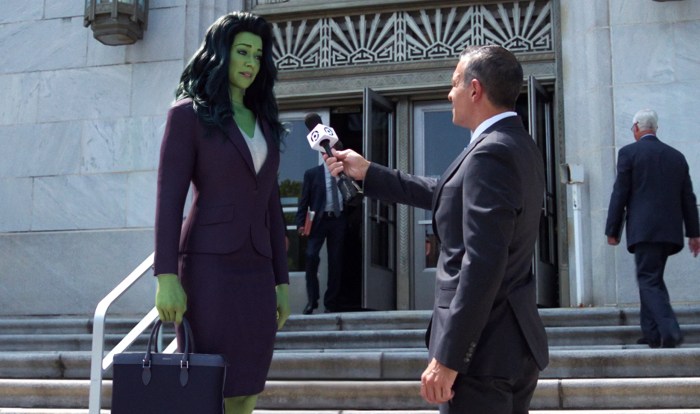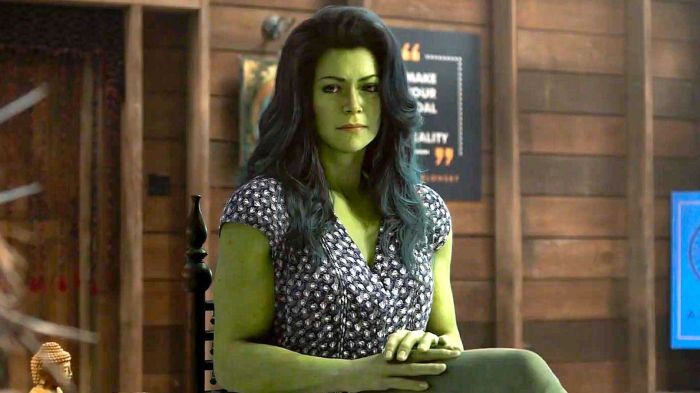She-Hulk: Attorney at Law stands apart from other superhero narratives through its unique blend of legal drama, comedic timing, and meta-commentary. This exploration delves into the director’s vision for the series, analyzing how their choices in casting, visual style, and narrative structure contributed to the show’s overall success and distinctive tone. We’ll examine the director’s approach to balancing humor and legal intricacies, and consider how this impacted the portrayal of Jennifer Walters, her relationships, and the legal cases presented.
The series cleverly uses its legal framework to explore broader themes of gender, power dynamics within the legal system, and the representation of diverse characters. This analysis will also examine how the director’s choices shaped the show’s social commentary, comparing and contrasting its approach with other Marvel productions and legal dramas. We’ll explore She-Hulk’s unique legal strategies, her character arc, and the significance of her relationships with both colleagues and family.
She-Hulk’s Role as a Lawyer

Jennifer Walters, aka She-Hulk, brings a unique perspective to the legal profession, blending her superhuman abilities with her sharp legal mind. The show depicts her navigating the complexities of the law while also grappling with the challenges of being a superpowered individual. Her experience as a lawyer informs her superhero identity, and vice-versa, creating a compelling dynamic.
She-Hulk’s legal expertise and specialization primarily lie in superhuman-related law. This is a niche area, requiring a deep understanding of both legal frameworks and the unique capabilities and vulnerabilities of individuals with extraordinary abilities. While she initially works at a general law firm, her unique skill set eventually leads her to handle cases involving conflicts related to superhuman rights, powers, and their societal implications. Her experience in more traditional legal fields, however, allows her to approach superhuman law with a broader and more well-rounded perspective than most.
Cases Handled by She-Hulk
She-Hulk handles a diverse range of cases, often involving clients with superhuman abilities or those affected by superhuman activities. For example, she defends individuals wrongly accused of crimes they didn’t commit due to misunderstandings of their powers. Conversely, she might prosecute individuals who misuse their abilities for criminal purposes. A recurring theme involves navigating the ethical and legal grey areas that arise from the coexistence of humans and superhumans, often necessitating creative legal strategies and interpretations of existing laws. The complexity lies in applying human laws to situations that far exceed the scope of ordinary human experience. One notable example involves the legal ramifications of accidental property damage caused by a superhuman’s uncontrolled powers. The challenge here is determining liability, damages, and the application of insurance law to extraordinary circumstances.
She-Hulk’s Courtroom Strategies
She-Hulk’s courtroom strategies often leverage her unique abilities. While maintaining a professional demeanor, she uses her enhanced intellect and quick wit to dissect complex arguments, anticipate her opponent’s moves, and effectively present her case. Her superhuman strength and reflexes, while not directly used in the courtroom, provide her with a level of confidence and assurance that allows for more aggressive and effective advocacy. Unlike traditional lawyers who might rely solely on legal precedent and meticulous preparation, She-Hulk sometimes incorporates a more intuitive and almost instinctive approach, reading her opponents and adapting her strategies in real-time. This adaptability, however, is always rooted in a solid foundation of legal knowledge and understanding.
Comparison with Other Marvel Lawyers
She-Hulk’s approach to law differs significantly from other prominent Marvel lawyers like Matt Murdock (Daredevil). While Daredevil’s legal practice is often intertwined with his vigilante activities, his methods tend to be more morally driven and less focused on strictly legal technicalities. He often operates in the grey areas of the law, prioritizing justice over legal procedure. She-Hulk, while also possessing a strong sense of justice, maintains a more traditional legal approach, working within the existing legal system to achieve her goals. This contrast highlights the diverse ways individuals can use legal skills to promote justice within the Marvel Universe.
The Director’s Vision for the Show
The creative vision behind “She-Hulk: Attorney at Law” aimed to deliver a fresh take on the superhero genre, blending the established Marvel Cinematic Universe (MCU) with a sharp, comedic legal drama. The directors sought to create a show that was both entertaining and empowering, showcasing a strong female lead navigating both her professional and superhero life. This involved careful consideration of casting, visual style, and the delicate balance between humor and serious legal themes.
The overall goal was to create a show that felt both familiar to MCU fans and unique in its approach to storytelling. The directors successfully leveraged the established MCU aesthetic while simultaneously forging a distinct visual identity for the series, one that reflects the protagonist’s personality and professional environment. This involved a deliberate choice of tone, a vibrant color palette, and a stylistic approach that differentiated it from other MCU productions.
Casting Choices and Their Impact
Casting choices were instrumental in achieving the show’s comedic and empowering tone. Tatiana Maslany’s portrayal of Jennifer Walters/She-Hulk was crucial. Her ability to convincingly portray both the lawyer and the superhero, and to shift between her serious and comedic sides, grounded the show’s fantastical elements in relatable human experiences. The casting of supporting characters, like Mark Ruffalo as Bruce Banner and Jameela Jamil as Titania, also contributed to the show’s overall success, with each actor bringing a unique comedic sensibility to their roles. These choices ensured a strong ensemble cast that enhanced the comedic timing and the overall effectiveness of the show’s storytelling.
Set Design and Visual Style
The set design played a vital role in establishing the show’s distinct visual identity. The vibrant, modern law firm offices contrasted sharply with the more muted tones often associated with superhero productions. This contrast helped underscore the dual nature of Jennifer Walters’ life, highlighting the mundane realities of her professional life against the backdrop of extraordinary superhero capabilities. The visual style, characterized by a bright and energetic color palette, further enhanced the show’s comedic tone, avoiding the darker, more serious aesthetic often found in other superhero shows. This approach directly reflected the show’s lighthearted nature and Jennifer’s personality.
Balancing Humor and Legal Drama
The show’s success hinges on its ability to seamlessly blend humor and legal drama. The directors achieved this balance by carefully crafting storylines that integrated legal cases with superhero elements. Legal proceedings weren’t just backdrops; they were integral parts of the narrative, providing opportunities for both witty dialogue and genuine emotional depth. The show successfully avoided undermining the legal aspects with excessive humor, ensuring that the comedic elements complemented, rather than overshadowed, the serious themes. The humor served to lighten the tone and make the legal proceedings more accessible to a wider audience, while maintaining the integrity of the legal procedures.
Directorial Decisions and Their Impact on Tone and Message
The directors’ commitment to showcasing a strong, independent female lead directly impacted the show’s message. Jennifer Walters’ journey, juggling her career and superhero life, resonated with audiences. The show tackled themes of body image, sexism within the legal profession, and the pressures of fame and public scrutiny. These were woven into the narrative organically, avoiding heavy-handedness. The directorial choices regarding the pacing, the use of breaking the fourth wall, and the inclusion of meta-humor, all contributed to the show’s overall unique and engaging tone. The choice to break the fourth wall, for example, allowed the show to directly engage with the audience, creating a unique and playful viewing experience.
Hypothetical Alternative Directorial Approach
A hypothetical alternative approach could have focused on a more serious and dramatic tone, minimizing the comedic elements and emphasizing the darker aspects of superhero life and the legal profession. This approach could have explored the ethical dilemmas faced by superheroes and the inherent conflicts between personal life and public responsibility more intensely. Such a change would have resulted in a vastly different series, likely appealing to a more mature audience and potentially leading to a more somber and introspective narrative. The show might have focused on the sacrifices and burdens of being a superhero, perhaps exploring themes of isolation and moral ambiguity more prominently, potentially resulting in a more critically acclaimed, though possibly less commercially successful, series. This contrasts with the chosen approach which prioritizes humor and accessibility, resulting in a more broadly appealing, albeit potentially less critically acclaimed, product.
Legal Themes and Social Commentary

She-Hulk: Attorney at Law deftly weaves together legal proceedings with sharp social commentary, offering a unique perspective on gender dynamics, power imbalances, and the inherent biases within the legal system. The show doesn’t shy away from tackling complex issues, using humor and legal intricacies to highlight its points.
Prominent Legal Themes
The series explores several key legal themes, including but not limited to, intellectual property rights (as seen in the superhero persona ownership disputes), contract law (demonstrated through She-Hulk’s various client cases), and the complexities of superhero-related litigation. The show also touches upon defamation, privacy rights, and the ethical considerations faced by lawyers navigating a world where superpowers exist. These legal themes are not merely background elements; they are central to the plot and character development, forcing Jen Walters to confront the intersection of her personal life and professional responsibilities.
Social Commentary on Gender, Power, and the Legal System
She-Hulk directly addresses societal biases against women, particularly within male-dominated fields like law and the superhero community. Jen’s experiences as a female lawyer, juggling both her professional and superhero identities, highlight the challenges women face in balancing career ambitions with societal expectations. The show critiques the power dynamics inherent in legal proceedings and the ways in which these dynamics are often exacerbated by gender. The show also implicitly criticizes the often-unfair and unequal application of the law, highlighting the systemic biases that affect marginalized communities.
Representation of Diverse Characters and Their Legal Struggles
The show features a diverse cast of characters facing unique legal struggles. These characters represent a range of backgrounds, ethnicities, and experiences, broadening the scope of legal issues explored. The show’s commitment to diverse representation allows for a more nuanced and comprehensive examination of the legal system’s impact on different communities. For instance, the show’s handling of cases involving marginalized communities, though not always explicitly focused on these groups, implicitly critiques the system’s shortcomings in providing equal justice for all.
Comparison to Other Legal Dramas
Unlike many traditional legal dramas that focus primarily on courtroom theatrics, She-Hulk blends legal proceedings with superhero action and comedic elements. This unique approach allows for a lighter, more accessible exploration of complex legal themes. While shows like Suits focus on corporate law and ambitious lawyers, She-Hulk tackles a broader range of legal issues and societal concerns, specifically focusing on the unique challenges faced by women and individuals with extraordinary abilities. The show’s humor and self-awareness also differentiate it from more serious legal dramas, making it more engaging for a wider audience.
Comparison of Key Legal Cases
| Case | Plaintiff | Defendant | Key Legal Issue |
|---|---|---|---|
| Intellectual Property Rights Case | She-Hulk/Jennifer Walters | Various parties claiming ownership of her image/persona | Ownership of a superhero identity, right of publicity |
| Defamation Case | A client falsely accused of a crime | A news organization/individual | Freedom of the press vs. individual’s right to reputation |
| Contract Dispute | A client with a breached contract | Another party involved in the contract | Breach of contract, specific performance, damages |
Closing Summary

Ultimately, She-Hulk: Attorney at Law, under the direction of [Insert Director’s Name if known, otherwise remove bracketed information], demonstrates a successful fusion of legal procedural drama and superhero storytelling. The director’s innovative approach to character development, visual style, and social commentary resulted in a refreshingly unique series that both entertains and provokes thought. By analyzing the director’s choices and their impact on the show’s narrative, we gain a deeper understanding of the series’ success and its lasting contribution to the superhero genre.
Expert Answers
What specific legal specializations does She-Hulk focus on in the show?
While not explicitly stated, She-Hulk’s cases suggest a specialization in superhuman-related legal issues, often involving contracts, damages, and torts related to superhuman abilities and actions.
How does She-Hulk’s approach to law differ from other Marvel lawyers like Matt Murdock (Daredevil)?
She-Hulk’s approach is more pragmatic and less morally rigid than Daredevil’s. She’s willing to bend the rules more creatively to achieve the best outcome for her clients, while Daredevil often prioritizes strict adherence to the letter of the law and a stricter moral compass.
Were there any significant casting decisions that particularly impacted the show’s tone?
The casting of Tatiana Maslany as She-Hulk was crucial in establishing the show’s comedic tone and allowing for the meta-commentary aspects. Her ability to portray both the human and Hulk sides convincingly was essential.
What is the significance of the show’s frequent breaking of the fourth wall?
Breaking the fourth wall allows the show to directly address the audience, creating a sense of intimacy and self-awareness. It also allows for comedic moments and commentary on the superhero genre itself.